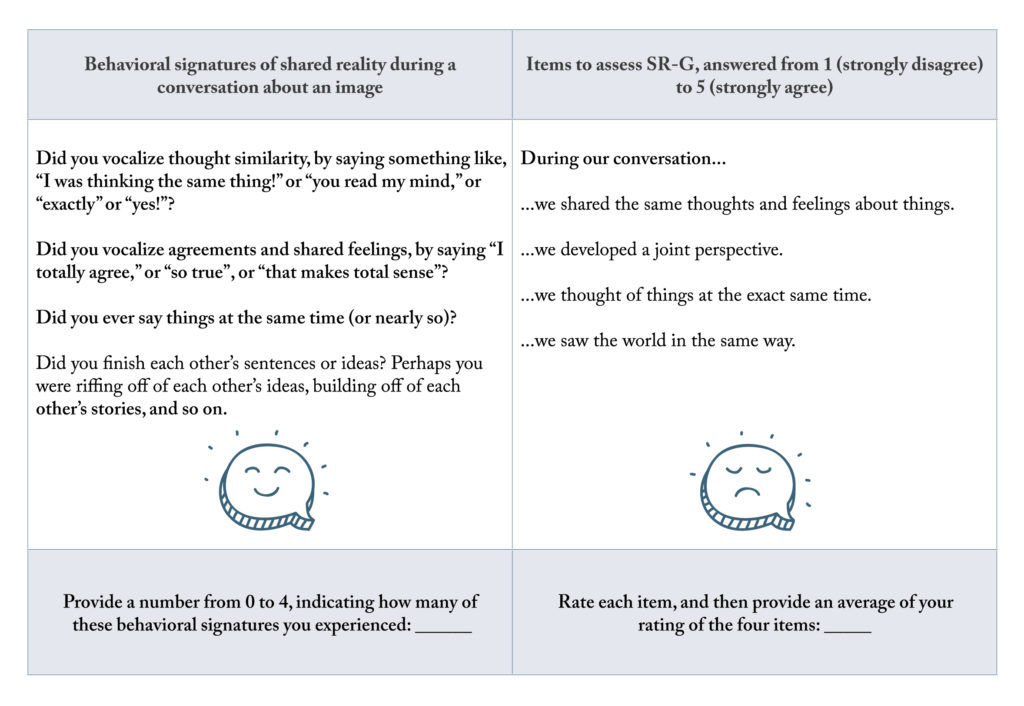Practice
Teaching Current Directions: Shared Reality

Teaching Current Directions in Psychological Science offers advice and guidance about teaching a particular area of research or topic covered in this peer-reviewed APS bimonthly journal, which features reviews covering all of scientific psychology and its applications.
Shared Reality: The Human Motive to Connect and Be Understood
By Beth Morling, University of Delaware
Edited by C. Nathan DeWall, University of Kentucky
Student Activity: Sharing Reality with a Partner
Dyads can share reality, too. Generalized shared reality (SR-G) occurs when two people share inner states with respect to a variety of targets (Rossignac-Milon et al., 2021). SR-G can happen when dyads share similar views on music, current events, or celebrities; couples may have inside jokes or “our song.” SR-G can also explain those magic moments when we “just click” with someone. SR-G fulfills both motives: to feel close and to feel right.
See if you can create a few such moments with this classroom exercise. Ask your students to sit with another person whom they do not already know (in a remote class, you could create novel dyads in breakout rooms). Display the image and questions below on a slide. You and your partner will work together to answer several questions about the picture below. Your goal will be to figure out together what you think is really going on in the picture. You will have 2 minutes to discuss each question.

1. Why do you think the person in the white shirt and the person standing behind the couch are talking?
2. What do you think will happen next (after the moment of the picture)? Why?
3. Considering what you have discussed, how do you think you would feel in this situation if you were the person in the white shirt? After the conversation, ask students to privately reflect on which of the behavioral markers of SR-G they experienced and rate their interaction using the SR-G assessment items (see Table 1).
Time permitting, correlate the number of behavioral markers each dyad experienced (column 1) with their SR-G responses (column 2), using one response per dyad. Employing this method in earlier research, Rossignac-Milon and colleagues found a positive correlation between behavioral signatures of shared reality and dyadic SR-G scores (Rossignac-Milon et al., 2021). Consistent with the theory, ratings of SR-G predicted both relational variables (e.g., the extent to which pairs of dyads felt like they “clicked”) and epistemic ones (e.g., the feeling that “my partner is a person whose judgment I trust”).
To further students’ understanding, pose these discussion questions:
1. Reflect on a shared reality you have experienced, either in the class exercise or in your real-world relationships. How does it feel? (The instructor should amplify responses that mention both relatedness and epistemic motives.)
2. SR-G differs from sharing traits with another person. You and a partner might both come from the same hometown and be psychology majors—but you might not “click” in the shared-reality sense. Can you think of additional examples of how shared reality is different from simple similarity? (The instructor can amplify how SR-G occurs in the moment and is about sharing inner states with respect to the outside world.)
As you close out the lesson, direct interested students to this BBC journalist’s take on how SR-G helps dyads “click” (Leslie, 2020).
Your 9-month-old, squealing excitedly, points to something she sees across the park.
- Across the room at a party, your spouse flashes you That Look, which you both know means “this guy’s a mansplainer!”
- Two college roommates crack up, exclaiming, “I was just going to say that!”
These exchanges charm us. They are tiny instances of shared reality—moments that reflect deep human motives to be connected and understood.
Shared reality can describe a perceived state, such as when two people simultaneously remark how much they love The Circle. But shared reality also describes a human motivation, manifested when a baby points or when a spouse tells a secret. E. Tory Higgins, Maya Rossignac-Milon, and Gerald Echterhoff (2021) introduce shared reality as “the perceived commonality of inner states (feelings, judgments, concerns) with other people.”
Humans seem uniquely motivated to share inner states. If adults turn their head to stare across the room, most 8-month-old infants (and even some 2-month-olds) will follow their gaze, as if infants want to share adults’ perceptions (Scaife & Bruner, 1975). Babies as young as 7 months point at novel objects with the apparent intent of wanting us to notice them, too. Higgins marvels at this motivation. Any animal that has arms and can make sounds is functionally able to point, he wrote in an email. “As far as intelligence goes, it’s not that impressive.” But only humans seem motivated to actually do it. “[Only] human infants want to share with another what they find interesting…. It is a difference in motivation, not a difference in intelligence” (personal communication, April 2021).
When shared reality is achieved, it satisfies core human motivations both to understand and to relate to others (Higgins, 2019). In their Current Directions article, the authors summarize two major lines of research.
Sharing is believing (…and remembering)
The sharing-is-believing effect describes a memory bias. When people describe something to another person, they later describe and remember it in a way that matches that person’s opinion. For example, if Alex and Jordan discuss a movie, Alex will describe it positively if Jordan liked it (or negatively if Jordan disliked it). After that conversation, Alex’s memory will shift toward her own description, which was tuned to Jordan’s opinion (Echterhoff et al., 2005). Alex will remember the movie more positively (or negatively) than she would have otherwise, especially if the two felt they created a shared understanding.
The sharing-is-believing effect illustrates our motivations both to connect with others and to make sense of the world. The effect is strongest when people share messages with in-groups, suggesting that sharing reality both depends upon and builds up trusted bonds. Sharing messages with close others also leads people to conclude that those messages are true; in any memory system, true messages should be stickier.
Perhaps the sharing-is-believing effect can be a teaching tool. By explaining a concept to a trusted teacher, students must tune their message to an in-group audience who already understands the concept. The resulting sense of shared reality could make the concept more memorable.
Feedback on this article? Email [email protected] or scroll down to comment.
References
Echterhoff, G., Higgins, E. T., & Groll, S. (2005). Audience-tuning effects on memory: The role of shared reality. Journal of Personality and Social Psychology, 89(3), 257–276. https://doi.org/10.1037/0022-3514.89.3.257
Higgins, E. T. (2019). Shared reality: What makes us strong and tears us apart. Oxford University Press.
Leslie, I. (2020, September 20). What makes strangers click? BBC Worklife. bbc.com/worklife/article/20200917-what-makes-strangers-click.
Rossignac-Milon, M., Bolger, N., Zee, K. S., Boothby, E. J., & Higgins, E. T. (2021). Merged minds: Generalized shared reality in dyadic relationships. Journal of Personality and Social Psychology, 120(4), 882–911. https://doi.org/10.1037/pspi0000266
Scaife, M., & Bruner, J. S. (1975). The capacity for joint visual attention in the infant. Nature, 253(5489), 265–266. https://doi.org/10.1038/253265a0
Sokolowski, K., Schmalt, H.-D., Langens, T. A., & Puca, R. M. (2000). Assessing achievement, affiliation, and power motives all at once: The multi-motive grid (MMG). Journal of Personality Assessment, 74(1), 126–145. https://doi.org/10.1207/S15327752JPA740109






APS regularly opens certain online articles for discussion on our website. Effective February 2021, you must be a logged-in APS member to post comments. By posting a comment, you agree to our Community Guidelines and the display of your profile information, including your name and affiliation. Any opinions, findings, conclusions, or recommendations present in article comments are those of the writers and do not necessarily reflect the views of APS or the article’s author. For more information, please see our Community Guidelines.
Please login with your APS account to comment.